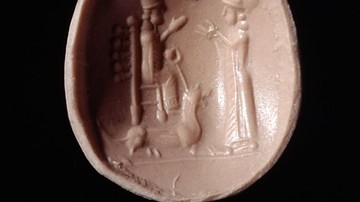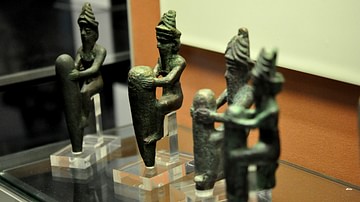In ancient Mesopotamia, the gods informed every aspect of daily life including the practice of medicine. Gula, the Sumerian goddess of healing, presided over the medical arts, guiding doctors and dentists in the treatment of health problems, usually attributed to supernatural causes, for over 2,000 years. Many aspects of medicine later associated with Greece were pioneered in Mesopotamia.
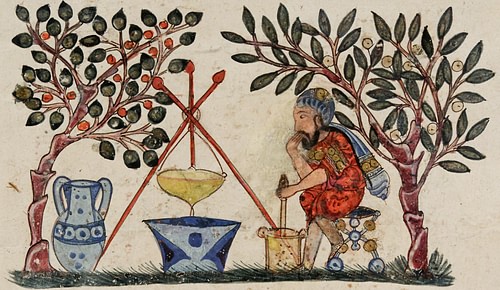
Gula (also known as Ninkarrak and Ninisinna) was not solely responsible for health and healing, however, but was assisted by her family including her consort Pabilsag (also a divine judge), her sons Damu and Ninazu, and daughter Gunurra. The rod intertwined with serpents, which today is the insignia of the medical profession, originated with her son Ninazu who was associated with serpents, transformation, the underworld, and healing.
Physicians in Mesopotamia were simply the agents through which such deities worked to maintain the health of the people and would be described today as general practitioners, specialists, surgeons, dentists, faith healers, and therapists. The doctor, by whatever name, was among the most highly educated professions in Mesopotamia and was always referenced with great respect.
A doctor had to first study to become a scribe, then focus on medical treatises, and finally concentrate on their specialization. Learning cuneiform script and mastering the curriculum of the scribal school took 10-12 years at least before one could devote oneself wholly to the study of medicine. Once recognized as a doctor, however, Mesopotamian physicians generally lived very comfortable lives.
Medicine & the Gods
The primary function of the physician then, as now, was to heal people of illnesses and keep them in good health. The first step in treating a sick person was diagnosing the cause of the illness (just as it is today), and that cause was almost always attributed to a sin the patient had committed, whether knowingly or unknowingly. Scholar Jean Bottero writes:
Every breach of whatever norm – immemorial 'bans'; customary imperatives; implicit instructions of the law, or explicit instructions of the authorities – became an offence against the rule of the gods, a 'misdeed' against them, a 'sin'. And as sovereigns punish anything that defies their authority, it was now up to the gods to suppress such unruliness with suitable punishments. These punishments were the ills and misfortunes of life, no longer inflicted by demons on a whim [as was previously thought] but henceforward on the orders of the gods. (168)
Illness was referred to as 'the hand of…', as in "The patient is touched by the hand of the god Shamash" or "The hand of the demon Lamashtu is upon her" or the hand of this or that unhappy ghost. Whatever malady the patient presented with, and whatever the final cure, the diagnosis always referenced the will of the gods and their intervention in human affairs. Illness, then, equaled sin, and a cure for that illness required some form of confession and a commitment to do better in the future.
Even so, it was entirely possible for a sick person to do everything right, and for the doctors to perform every incantation correctly and apply the proper medicines, and yet the patient would still die. Even if one god intended only the best for the sick person, another god could have been offended and would refuse to be placated, no matter what offerings were made. To further complicate the situation, one also had to consider that it was not the gods causing a problem but, instead, a ghost whom the gods allowed to cause the trouble to rectify some wrong. Scholar Robert D. Biggs comments:
The dead – especially dead relatives – might also trouble the living, particularly if family obligations to supply offerings to the dead were neglected. Especially likely to return to trouble the living were ghosts of persons who died unnatural deaths or who were not properly buried – for example, death by drowning or death on a battlefield. (4)
Medical texts from the Library of Ashurbanipal (r. 668-627 BCE) make it clear, however, that doctors had an impressive amount of medical knowledge and applied this regularly in caring for their patients and appeasing the gods and the spirits of the dead. Prior to the 19th-century discovery of ancient Mesopotamian inscriptions like those found at Nineveh and Mari, scholars believed that the Mesopotamians had no doctors at all because of the account given by the Greek historian Herodotus (l. c. 484-425/413 BCE) in his Histories:
Because they do not consult doctors, when someone is ill, they carry him to the main square, where anyone who has personal experience of something similar to what the ill person is suffering from, or who knows someone else who has, comes up to him and offers him advice and suggestions about his illness. They tell him what remedy they found effective in their own case, or what they saw working in someone else's case, which enabled them to recover from a similar illness. (I.197; Waterfield, 87)
While this custom may have been observed in parts of Mesopotamia in Herodotus' time, it certainly was not for most of Mesopotamian history, and it is likely that Herodotus was relaying secondhand information. The medical profession was well-established in ancient Mesopotamia by the Old Babylonian Period (2000-1600 BCE).

The Asu & Asipu
There were two primary types of doctors throughout Mesopotamia's history:
- the asu (a medical doctor who treated illness or injury empirically)
- the asipu (a healer who relied upon what one would call 'magic')
There were also surgeons (who seem to have come from either of these medical backgrounds) and veterinarians (who also could be either asu or asipu). Dentistry was practiced by both kinds of doctors, and both may have also presided at births, although their role is unclear in this. It is possible that the asipu could have recited prayers to the gods or chants to ward off demons (most notably the demon Lamashtu who killed or carried off infants) or that the asu could have eased labor pains with herbs but not assisted with the actual birth, which was handled by a midwife.
A pregnant woman, and one who was in labor, wore special amulets to protect her unborn child from Lamashtu and to invoke the demon Pazuzu who served as a protective entity; in the same way that Pazuzu could harm, so could he also protect, and he features frequently in the incantations of the asipu. Although modern-day scholarship sometimes refers to the asipu as a 'witch doctor' and the asu as a 'medical practitioner', the Mesopotamians regarded the two with equal respect. Biggs notes:
There is no hint in the ancient texts that one approach was more legitimate than the other. In fact, the two types of healers seem to have had equal legitimacy, to judge from such phrases as, 'if neither medicine nor magic brings about a cure', which occur a number of times in the medical texts. (1)
The significant difference between the two types was that the asipu relied more explicitly on supernatural incantations and prayers, while the asu dealt more directly with the physical through balms and herbal medicines. Both types of healers would have accepted the supernatural source for illness, however, and the asu should not be considered more 'modern' than the asipu.
The Physician at Work
Both types of physicians operated out of the temples and treated patients there but more often made house calls. The city of Isin was the cult center for the goddess Gula, and it is thought (though not entirely certain) that Isin served as a training center for physicians who were then sent to temples in various cities as needed. There is no evidence of private practice per se, although kings and the more affluent had their own physicians.
Women and men could both be doctors, though, as Bottero notes, "Women scribes or copyists, exorcists or experts in deductive divination [the asipu and asu] could be counted on the fingers of one hand" (117). It seems as though there were more female physicians during the Early Dynastic Period of Sumer (2900-2334 BCE) than in later eras, and that women in ancient Mesopotamia generally played a larger role in medicine prior to the Akkadian Period (2334-2218 BCE) and the propagation of the view of women as less capable than men.
From ancient texts, it is known that doctors shaved their heads (in some periods only on the left side) as a means of professional identification. From the Gula Hymn (c. 1400 BCE) we know that doctors traveled about their city daily and carried with them the tools of their trade. Part of the hymn reads:
I am a physician, I can heal,
I carry around all healing herbs, I drive away disease,
I gird myself with the leather bag containing health-giving incantations,
I carry around texts which bring recovery,
I give cures to mankind.
My pure dressing alleviates the wound,
My soft bandage relieves the sick.(Biggs, 10)
The physician, of both types but primarily the asu, also made use of beds. Scholar Emily K. Teall notes:
A categorized list of physician's equipment details a bed and coverlet among surgical instruments and other medical trappings ... seriously afflicted patients were examined and treated in bed, which [could also serve as] the operating table. A coverlet could well be utilized in post-operative recovery. (2)
Whether this means that doctors carried a portable bed with them or simply made use of patients' own beds is unclear. The Mesopotamians understood sickness being associated with uncleanliness, (though they did not recognize germs as one would today) and since the poorer people of the cities slept on mats on the dirt floor, a bed to elevate a sick person for treatment would make sense.
Treatments & Prescriptions
Fees for services were on a sliding scale depending on one's social status. A doctor presiding over the birth of a noble was paid more than for a common birth, and this custom was observed long before the Code of Hammurabi (c. 1772 BCE) systematized medical practice. Prescriptions were on this same scale, and whereas a doctor might be paid in gold for mixing a remedy for a prince, the payment for doing the same for a common person might be a bowl of soup or a clay cup. There is no evidence, however, that doctors hesitated in treating the poor, and the same prescriptions were given, with the same ingredients, without regard for a patient's social status.
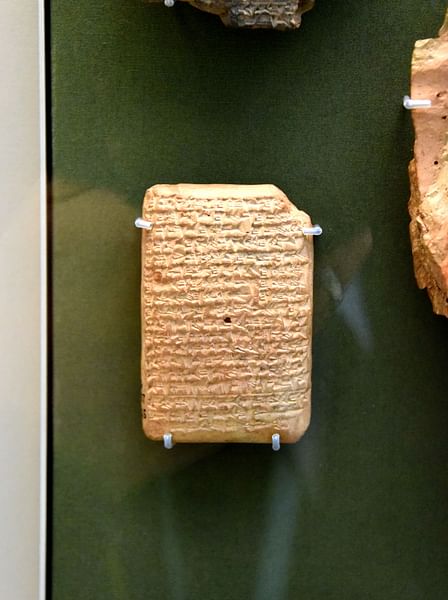
Medicines were usually ground by the doctor in the presence of the patient, while some incantation was recited. A prescription from Babylon for an injury to the face reads:
If a man is sick with a blow on the cheek, pound together fir-turpentine, pine-turpentine, tamarisk, daisy, flour of Inninnu; mix in milk and beer in a small copper pan; spread on skin, bind on him, and he shall recover. (Teall, 4-5)
Antiseptics were made from a mixture of alcohol, honey, and myrrh, and surgery was more advanced than in other regions of the time (Teall, 5). Teall writes: "In the treatment of all wounds, there are three critical steps: washing, applying a plaster, and binding the wound." (6) The Mesopotamians recognized that washing a wound with clean water, and making sure the doctor's hands were also clean, prevented infection and hastened healing. Hands and wounds were cleaned with a mixture of beer and hot water though, as Teall notes, "a liquid soap was already available" (6).
Dentists & Sex Therapists
Biggs notes that "we have little evidence for the practice of dentistry as such" (7), but dentistry was practiced in Sumer by the Uruk Period (4100-2900 BCE). A toothache was thought to be caused by a 'tooth worm' that, after its creation by the gods, refused all form of food except the blood from teeth. A dentist would recite the incantation of the tooth worm and then administer a procedure, whether herbs or pulling the tooth, as the gods were called upon to smite the tooth worm and drive it from the patient. This seems to have been a standard and effective procedure, as it was consistently practiced.
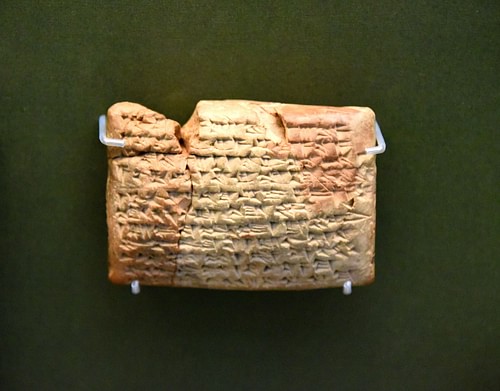
Doctors also treated gastrointestinal problems, urinary tract infections, skin problems, heart disease, and mental illness. There were also gynecologists specializing in women's health, including abortions. Biggs notes:
There is one text that apparently gives prescriptions for aborting a fetus. The relevant line reads, 'to cause a pregnant woman to drop her fetus.' The prescriptions consist of eight ingredients to be administered to the woman in wine and be drunk on an empty stomach. The section ends with the words, 'that woman will drop her fetus'. (9)
He also notes that, "the asipu was a sort of sex therapist. There was a special collection of texts known by its Sumerian name, SA ZI GA…literally 'lifting of the heart', where 'heart' seems to be a euphemism for penis" (15). These texts also deal with fertility problems in women but seem primarily focused on sexual potency in males and arousal in females.
There is even a pregnancy test mentioned in the medical texts whereby certain herbs were worn by a woman in her underwear which would absorb vaginal secretions and change color if the woman was pregnant. There were also practices ensuring fertility, optimal days during which a woman was more likely to conceive, and others to increase a woman's sexual desire after giving birth.
Medicine & Magic
Doctors were not held liable if these procedures did not work. As the gods were the direct causes and curative agents of disease, a physician could only be held accountable for what he or she did or did not do in administering a procedure. If an accepted course of treatment was followed precisely as written, even if the patient was not cured, the doctor had performed properly.
The only exception to this rule concerned surgery where, if the operation failed, the doctor would have a hand (or both hands) amputated, as noted by mandate 218 of Hammurabi's Code. Surgery was performed by the time of the Uruk Period even though Mesopotamian surgeons had no knowledge of physiology or anatomy since dissection of a human corpse was forbidden on religious grounds.
Although doctors understood the importance of taking a patient's pulse to determine one's state of health and recognized the importance of antiseptics and cleanliness, they never equated the pulse with a circulatory system, nor did they completely recognize uncleanliness as encouraging germs which caused infection. Since illness was thought to come from supernatural agencies, doctors always relied, to greater or lesser degrees, on treatments involving what one would recognize today as 'astrology' and 'divination', especially the importance of omens.

This is seen through certain medical texts, known as the omen series, written down over many centuries, which make clear how successful an asipu will be based upon what sights the doctor sees while en route to the patient's home:
If the exorcist sees either a black dog or a black pig, that sick man will die. If the exorcist sees a white pig, that sick man will live. If the exorcist sees pigs which keep lifting up their tails, as to that sick man, anxiety will not come near him.
(Nemet-Nejat, 79-80)
Following these predictions are others which describe certain diseases and symptoms and state how, based upon what is observed, the patient will either live or die. Dreams and visions of the patient are also considered:
If, when he was suffering from a long illness, he saw a dog, his illness will return to him; he will die. If, when he was suffering from a long illness, he saw a gazelle, that patient will recover. If, when he was suffering from a long illness, he saw a wild pig, when you have recited an incantation for him, he will recover.
(Nemet-Nejat, 81)
At the same time that these 'magical' practices were in place, however, there was the continued use of diagnoses based on empirical observation and practical application of standardized treatment and conduct. The most famous instance of this is a letter from Zimri-Lim, King of Mari, to his wife concerning a woman of the court named Nanna who was suffering from some communicable disease. The king instructs his wife to keep Nanna from the others at court because the disease she has is contagious. This concept of contagion was never equated with the spread of germs, however; it was instead concluded that Nanna had committed some sin which made her ill and that, by proximity to the sick person, the gods might allow that disease to spread to others.
Conclusion
It would fall to the Egyptians to emphasize empirical observation and apply what one would term 'modern' procedures in medicine. From Egypt, medical practice came to Greece and was codified by Hippocrates (l. c. 460-370 BCE), known as "the father of western medicine." Biggs notes:
There are some parallels between Mesopotamian medicine and medicine as attested in ancient Greece, but it does not appear that Greek medicine (in contrast to such fields as mathematics and astronomy) was in any way derivative of Mesopotamian medicine. (17)
Even so, the practices of the Mesopotamians certainly influenced the Egyptians from whom the Greeks received their understanding of medical practice and general healthcare. Teall writes:
More than a thousand years prior to the lifetime and teaching of Hippocrates, prior to the description of the acquisition and treatment of wounds in the Iliad ... medicine in pre-1000 BCE Mesopotamia was a well-established profession that included diagnosis, pharmaceutical applications, and the proper treatment of wounds. (7)
It is notable that the staff with intertwining serpents, the symbol of the medical profession in the modern day, is associated with Hippocrates and the Greeks when, like medical practice itself, it originated in Mesopotamia.

